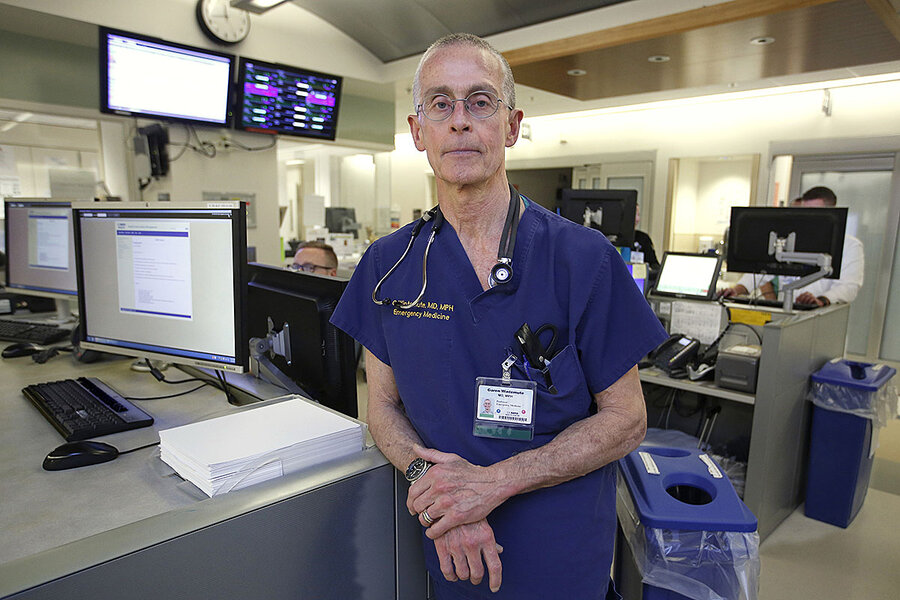Can arming doctors with data help reduce gun violence?
Loading...
| Sacramento, Calif.
When Dean Winslow questioned the wisdom of allowing civilians to buy semiautomatic assault rifles, his bid last year to become the Pentagon’s top health official sank. But he was inspired to establish Scrubs Addressing the Firearm Epidemic. The nonprofit group, made up of doctors and other health-care providers across the United States, plans to support public health research to shape strategies for reducing gun violence. “We need common-sense ways to address the problem,” he says. SAFE joins a growing number of organizations formed by physicians in recent years that approach gun violence as a public health crisis and focus on gathering data to help better identify and treat patients who could be at risk. “We have treatment guidelines for everything – alcoholism, opioid addiction...,” says Christopher Barsotti, co-founder of the American Foundation for Firearm Injury Reduction in Medicine. “But we don’t have any for this really pressing issue.”
Why We Wrote This
Congress axed funding for gun violence research more than 20 years ago. Now, physicians are leading the effort to reignite research and recast gun violence as a public health crisis.
Dean Winslow sat before the Senate Armed Services Committee last fall as President Donald Trump’s nominee to serve as the Pentagon’s top health official. His confirmation hearing, occurring two days after an Air Force veteran shot and killed 26 people inside a Texas church, appeared routine until a senator asked a question about the gunman’s military discharge status.
Dr. Winslow, a professor of medicine at Stanford University who deployed six times to Iraq and Afghanistan with the Air National Guard, offered his thoughts on the military’s discharge system. The retired colonel then added a personal aside born of outrage at the country’s latest mass shooting.
“But I also would like to — and I may get in trouble with other members of the committee — just say how insane it is that, in the United States of America, a civilian can go out and buy a semi-automatic assault rifle like an AR-15, which apparently was the weapon that was used,” he said.
Why We Wrote This
Congress axed funding for gun violence research more than 20 years ago. Now, physicians are leading the effort to reignite research and recast gun violence as a public health crisis.
The trouble arrived within moments. The late Sen. John McCain, (R) of Arizona, the panel’s chairman and a longtime gun supporter, reproached the nominee. “Dr. Winslow,” he said, “I don’t think that is your area of responsibility or expertise.”
McCain’s admonition foretold the end of Winslow’s nomination. The committee placed an indefinite hold on his appointment, and he withdrew from consideration a few weeks later.
But Winslow’s comment gave rise to an idea that could have deeper impact. He harnessed his frustration over mass shootings to co-found Scrubs Addressing the Firearm Epidemic (SAFE), a nationwide coalition of physicians, nurses, and other health care providers, along with medical students and professors. The nonprofit group supports public health research to shape strategies for reducing gun violence and advocates for public policy to encourage firearm safety.
“What happened at my confirmation hearing really galvanized me,” Winslow says. “A lot of us in health care have seen what guns do to the human body up close, and it’s not pretty. We need common sense ways to address the problem.”
SAFE has established chapters at medical schools in 16 states that will hold campus events on Sept. 17 to bring attention to the cause. The group joins a growing number of organizations formed by physicians in recent years to approach gun violence as a public health crisis. Their efforts sidestep politics and instead focus on gathering data to arm doctors with treatment guidelines for responding to a national scourge that claimed 38,658 lives in 2016.
“Physicians and health care workers deal with the effects of guns every day,” says Dr. Christopher Barsotti, who last year co-founded the American Foundation for Firearm Injury Reduction in Medicine (AFFIRM) in Williamstown, Mass. “So the question is how to mitigate those effects upstream from policy. And the answer is that we need high-quality research, and we need a lot of it.”
‘We’re just guessing’
Congress gutted funding for gun violence research more than 20 years ago. Lawmakers passed an amendment to a spending bill in 1996 that barred the Centers for Disease Control and Prevention from seeking to “advocate or promote gun control” and eliminated funding for firearm studies.
The chilling effect proved immediate and lasting, and in another setback for scientists, funding has expired for a National Institutes of Health gun research program launched in 2012. That further curtailed the agency’s limited work in the field aside from an initiative to examine gun-related deaths and injuries among children and a smattering of smaller projects.
The gun lobby’s success in pressuring legislators to slash federal funding has forced physicians to rely on stale data about the causes and effects of gun violence in a country where civilians own more than 393 million firearms. Stephanie Bonne, a trauma surgeon at University Hospital in Newark, N.J., explains that doctors, hampered by decades-old statistics, struggle to identify, treat, and refer patients who might present a threat to themselves or others.
“If we don’t have the evidence, we’re just guessing,” she says. For Dr. Bonne, co-chair of a gun violence prevention task force that the American Medical Women’s Association created in 2015, the daily flow of shooting victims through the trauma center reveals the human cost of outdated research.
“You feel so helpless as a physician because these wounds are just so devastating,” she says. “It’s so frustrating to talk to families and mothers over and over and tell them their children are dead from gunshot wounds.”
The campaign to cast gun violence as a public health crisis parallels earlier crusades that raised awareness about the hazards of smoking, unprotected sex, and failing to wear a seat belt. Yet broaching the topic of firearms with patients poses a dilemma for doctors because of the lack of evidence-based treatment practices and the country’s radioactive gun debate.
Suicide by firearm accounted for almost 23,000 deaths in 2016, or 63 a day. Dr. Barsotti, an emergency physician at hospitals in western Massachusetts and southern Vermont, recalls a pair of recent cases involving patients who had shown signs of suicidal intent. He found himself unsure of how — or whether — to talk about guns with them or their families even in the context of suicide.
“We have treatment guidelines for everything — alcoholism, opioid addiction, cancer,” he says. “But we don’t have any for this really pressing issue that has a tremendous impact on health care.”
The Violence Prevention Research Program based at the University of California, Davis launched an initiative earlier this year that offers suggestions to health care providers for discussing guns with at-risk patients, including counseling them on firearm safety. The Davis program houses a second research center devoted solely to gun violence that opened last summer with a five-year, $5 million grant from state lawmakers.
Prevention groups led by physicians seek to raise state and private funding for firearm research that would help medical professionals update treatment methods. Megan Ranney, the co-founder of AFFIRM and an emergency physician at Rhode Island Hospital in Providence, describes the opposition in Congress to funding gun studies as misplaced.
“Research isn’t for or against gun control. It isn’t political or partisan,” she says.“At its core, it’s about saving lives.”
Cold, hard, nonpartisan facts
Winslow served as commander of an Air Force hospital in Iraq in 2008, and in that role, he signed the death certificates of US troops killed in combat and those who died by suicide. The sight of young lives cut short by their own hand influenced his perspective on firearm safety.
The annual toll of civilian suicides and a litany of mass shootings in recent years inspired SAFE and convinced him that the harm wrought by firearms deserves status as a public health priority.
“We have a gun violence epidemic in this country that we can’t afford to ignore. We don’t want any more children to die,” Winslow says. Mindful of the polarized nature of the gun debate, he regards the high public standing of physicians, nurses, and other health care practitioners as a buffer against charges of partisanship as SAFE and similar groups nurture research efforts.
“Ultimately, people always bring politics into the discussion with guns,” he says. “But my hope is that the credibility of physicians will help defuse some of the political concerns.”
The American Medical Association, American Public Health Association, and other major medical groups have declared gun violence a national crisis, advocating for legislative reforms and federal funding of firearm research.
Lobbying by prominent health care organizations contrasts with the neutral line of nonprofits that doctors have formed in recent years. They view their mission asdefined by gun violence rather than gun ownership.
“It should be no different than talking about cars as a potential mechanism of injury,” Dr. Ranney says. “We can acknowledge that guns are allowed by the Constitution and still talk about how to keep people safe. These things are not mutually exclusive.”
The rallies held in Washington and cities nationwide to protest gun violence earlier this year after the fatal shooting of 17 people at a high school in Parkland, Fla., failed to persuade Congress to consider new gun laws.
The inertia has motivated a handful of states to act. David Studdert, a professor of medicine and law at Stanford University, asserts that the prospects of policy change at the state level could improve as SAFE, AFFIRM, and other organizations amass fresh data on gun violence.
“The political climate is not really ripe for federal legislation,” says Dr. Studdert, who has joined researchers at UC Davis to analyze whether owning a gun in California affects the likelihood of a person’s death. “But what happened after Parkland shows there is momentum for change, and physicians are a powerful constituency. White coats showing up in Sacramento could make a difference.”
In his work with AFFIRM, Barsotti, a gun owner, skirts mention of the Second Amendment to avoid provoking suspicions about the group’s purpose. He believes cold, hard, nonpartisan facts will light the path to reducing gun-related deaths and injuries by grounding the decisions of policymakers in research instead of rhetoric.
“It’s specious when talking about violence prevention to say that physicians want to take away guns,” he says. “We’re focusing on science and knowledge. Science informs policy and law. It always has in America.”








